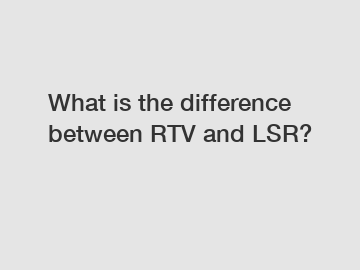What is the difference between RTV and LSR?
When it comes to manufacturing products that require precise and durable rubber components, two popular materials often come to mind — Room Temperature Vulcanization (RTV) and Liquid Silicone Rubber (LSR). While both these materials are commonly used in a variety of industries, there are some key differences that can significantly impact the end result. In this blog, we will delve into the dissimilarities between RTV and LSR, unraveling their unique properties, applications, and advantages. So, let's jump right in!
Understanding RTV:
Technically speaking, RTV refers to a family of silicone rubbers that can be cured at room temperature without the need for additional heat. This self-crosslinking behavior is attributed to the presence of a curing agent within the silicone matrix. These agents can vary, with each type offering specific properties, such as flexibility, hardness, and cure time.

RTV silicones are typically two-component systems, consisting of a base compound and a curing agent. Once these components are mixed together, a chemical reaction begins, transforming the rubber from a liquid state into a solid form. This versatility makes RTV a popular solution for various applications, including mold-making, encapsulation, gaskets, and prototypes.
LSR: A Different Breed of Silicone:
Moving on to Liquid Silicone Rubber (LSR), we encounter a material that stands apart from its RTV counterpart. LSR is a high-purity, platinum-cure silicone, meaning it requires heat in order to cure properly. The crosslinking process in LSR is triggered by a platinum catalyst, which ensures faster and more consistent curing compared to RTV.
Due to LSR's low viscosity, it can be easily injected into molds, resulting in intricate and precise final products. This particular characteristic makes it an excellent choice for applications where complex shapes and tight tolerances are required. Industries such as automotive, medical, and electronics often utilize LSR for its exceptional chemical resistance, biocompatibility, and thermal stability.
Properties and Applications:
To truly comprehend the dissimilarities between RTV and LSR, it is essential to delve into their unique properties:
1. Flexibility: RTV is known for its excellent flexibility, making it suitable for applications that require soft and stretchable components. LSR, on the other hand, offers a wider range of hardness options, making it ideal for both soft and rigid components.
2. Curing Time: LSR exhibits a faster curing time compared to RTV. This is highly beneficial in industries where efficient production is a priority, reducing the overall manufacturing time and improving productivity.
3. Precision: LSR's low viscosity enables it to replicate intricate details with precision, making it the preferred choice for industries where accuracy is crucial, such as medical devices and electronics.
4. Chemical Resistance: RTV silicones exhibit superior chemical resistance compared to LSR, making them well-suited for applications involving exposure to various chemicals or solvents.
Conclusion:
In summary, while both RTV and LSR share the common link of being silicone-based rubber materials, their unique properties and curing processes set them apart. RTV provides excellent flexibility and chemical resistance, making it suitable for a wide range of applications. On the other hand, LSR offers faster curing times, exceptional precision, and thermal stability, making it ideal for industries where accuracy and efficiency are of utmost importance.
Choosing between RTV and LSR ultimately relies on understanding the specific requirements of your project. Consulting with a trusted silicone manufacturer or an expert in the field would be the best way to ensure you select the appropriate material for your desired outcome. With this newfound knowledge, you are now equipped to make informed decisions and maximize the potential of silicone rubbers in your endeavors.
If you are looking for more details, kindly visit dispensing closure, dispensing closure, dispensing closure.

Comments
0